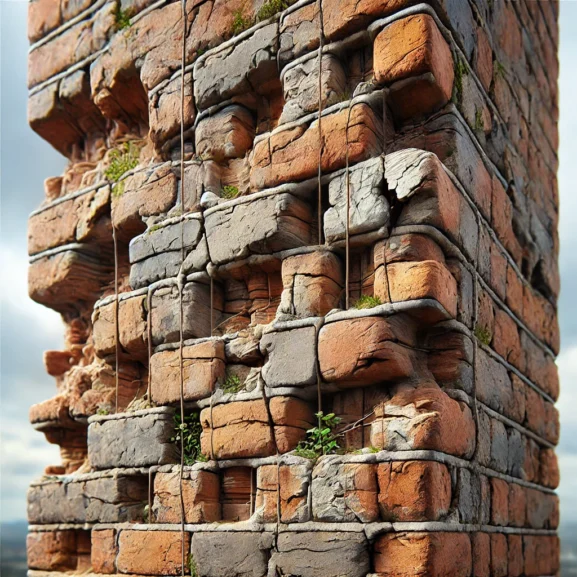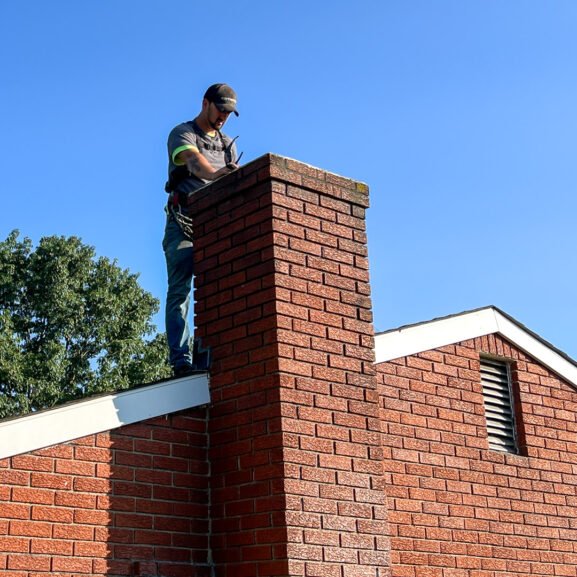Understanding Chimney Chase Deterioration in Prefabricated Chimneys: Causes and Solutions
A crackling fire is cozy. But we often forget about our chimneys. We don’t pay attention to them until something goes wrong. Prefabricated chimneys are popular because they are affordable and easy to install. However, they have their problems. One of the main issues is chimney chase deterioration. If not fixed early, this can cause serious damage and expensive repairs.
This article will explain why chimney chase deterioration occurs in prefabricated chimneys. We’ll explore the common causes and how they affect the chimney. You’ll learn what factors contribute to this problem and how to spot the signs early. We will also explain why monitoring and maintaining these structures is important. Weather exposure and material wear are just a few reasons why chimney chases can break down. By understanding what causes this, we can protect our homes. We can also make sure our fireplaces remain safe and work properly. Let’s dive in and learn how to protect our homes from these risks.
A Complete Guide to Prefabricated Chimneys
Prefabricated chimneys are popular because they are affordable and easy to set up. However, they need proper care. Without it, you might face issues like chimney chase decay and rusting. Let’s investigate how these chimneys work and what materials play a key role.
What Are Prefabricated Chimneys?
Prefabricated chimneys are factory-made units that are delivered and assembled on-site. They’re like IKEA for your fireplace—convenient and cost-effective. But unlike that Swedish bookshelf, these chimneys need expert installation to function safely. Prefabs usually work well with wood-burning, gas, or electric fireplaces. Chimney chases and faces unique challenges. The harsh weather there can cause chase deterioration faster. If we forget to maintain the chimney chase, it can lead to water damage and structural problems. For inspections and maintenance tips, check with the National Fire Protection Association. Reach out to certified professionals for a consultation.
Causes of Chimney Chase Deterioration
Let’s jump into the sneaky culprits behind the deterioration of prefabricated chimney chases. Not only are these little devils a tad annoying, but they also demand our attention to keep homes safe and warm.
Weather Impact
Weather can damage prefabricated chimney chases, especially in unpredictable climate. Rain, snow, and temperature changes all contribute to this damage. If the chase isn’t properly waterproofed, water can get in, leading to rust and corrosion. That’s why regular inspections are so important. For more about weatherproofing, check the National Fire Protection Association’s resources.
Quality of Materials
The choice of materials plays a significant role in the longevity of a chimney chase. Low-quality materials can lead to a damaged chase. They can’t withstand harsh weather. Over time, they start to break down. Opting for materials with appropriate weather resistance and durability prevents premature decay. Consistent chimney chase maintenance extends its life and enhances safety.
Installation Errors
Even the best materials won’t help if the installation goes sideways. Installation errors can lead to joint gaps and poor sealing, which invite moisture and reduce efficiency. To minimize prefabricated chimney problems, we suggest hiring skilled professionals for installation. Avoid trying to fix things yourself. Instead, reach out to certified professionals.
Keep your chimney chase protected and long-lasting. Visit CSIA for more safety tips. Don’t let chimneys become weather victims. Choose us for professional care.
Signs of Deterioration

Chimney chase deterioration in prefabricated chimneys can sneak up on us. It’s like forgetting a birthday. If we ignore it, the problem can grow. Eventually, it could lead to expensive repairs and frustration. The good news is there are clear signs we can watch for.
Visible Damage Indicators
It’s important to spot any visible damage in your prefabricated chimney chase. This helps prevent bigger issues down the road. Here are the key signs to look for:
- Rust Stains: Have you discovered rusty stains dancing on the chase cover? It’s a sign of water intrusion kicking off Chase rusting.
- Cracks and Gaps: Do you spot cracks or open gaps in the chase structure? These invite moisture and escalate chimney chase decay.
- Warped Metal: Notice bent or misshapen metal? This signals deteriorating chase conditions, possibly from harsh weather.
For guaranteed peace of mind, reach out to certified professionals for a complimentary consultation. We don’t recommend DIY fixes. It’s best to leave it to the pros.
Performance Issues
A prefabricated chimney chase should function smoothly, like a well-oiled machine. Here’s how to spot performance hiccups:
- Smoky Room: Is smoke trailing into the room instead of whirling up the chimney? Blockages or chase maintenance neglect may be at fault.
- Poor Draft: Does your fireplace struggle to create a good draft? This might tip you off to chimney hitches or weatherproofing oversights.
- Unusual Noises: Are there any odd creaks or groans when using the fireplace? Check for potential leaks or loose components.
Identifying these issues early helps curb major prefabricated chimney problems. For expert insights, we’re just a call away! Plus, find more safety tips at the National Fire Protection Association and CSIA.
Prevention and Maintenance Tips

Keeping our prefabricated chimney chase in top shape is key. Ignore it; we might face chimney chase problems that could leave us a soggy mess. Preventing chimney chase decay ensures a cozy, worry-free home.
Regular Inspections
Regular check-ups on our prefabricated chimneys help us catch problems early. This is even more important in areas where the weather changes quickly. We don’t want water or rust to take over our chimney chase. Experienced professionals can spot chase damage early, such as rust or gaps.
Let’s treat each inspection like a chimney wellness check to make this routine fun. This helps us avoid any sneaky surprises. Consult the Chimney Safety Institute of America (CSIA) for more inspection tips, or reach out to certified professionals for a consultation. For safety’s sake, always hire a pro—no DIY here!
Protective Coatings and Covers
Adding protective coatings and covers to our chimney chase is like giving it a raincoat, maybe even an umbrella. Chase waterproofing protects it from rain and snow, reducing the risk of damage. In unpredictable weather, weatherproofing our chimney chase keeps it strong.
Repair and Replacement Options
Repairing or replacing a deteriorating chase isn’t just about patching up a few holes. It involves knowing when a repair is enough, when to say goodbye, and when to opt for a new one. Prefabricated chimney problems require careful attention to ensure safety and efficiency.
When to Repair
Repairing the prefabricated chimney chase is a good option for minor problems. It can help prevent further damage. This approach is often quicker and more cost-effective than replacing the entire chase. By addressing small issues early, we can improve the chimney’s performance and safety. For instance, small cracks, slight chase rusting, or gaps on the surface can often be fixed. Spotting rust stains or warped metal a bit early could save a bundle.
- Minor Rust: If you spot a small rust patch, it’s important to address it immediately. Use the right chase protection. This can stop the rust from spreading and causing more damage.
- Small Cracks: Fixing cracks early stops them from expanding, maintaining the chimney’s integrity.
- Waterproofing Needs: Adding or updating Chase waterproofing helps reduce water damage.
Repair is ideal if the weather impact isn’t severe in your area. Reach out to certified professionals for consultation. For more safety tips, refer to CSIA and NFPA.
When to Replace
If severe damage is evident, replacing the chimney chase becomes necessary. Major chase decay and widespread rusting are signs that replacement is the only safe route.
- Extensive rust: Extensive rust can cause serious problems. When it covers large areas of the chase, the structure becomes weak. This can affect the safety and stability of the entire chimney system.
- Severe Damage: Big cracks and bends affecting the overall function need more than a patch job.
- Recurring Issues: Frequent repairs can add up. In the long run, investing in a new, weatherproofed component may be cheaper.
Prefabricated chimney chases face tough weather. A strong chase replacement can save you from future problems. It’s best to hire professionals for this. DIY repairs can be risky. Reach out to certified professionals to learn about replacement options to keep you safe and your chimney running smoothly.
Conclusion
Taking care of chimney chase deterioration in prefabricated chimneys is key to keeping our homes safe and running smoothly. These chimneys have special challenges. This is especially true in places, where the weather can change quickly. We can protect our investments by staying on top of inspections and repairs. It’s also a good idea to consult professionals when needed. Regular maintenance will help prevent costly damage and keep our chimneys lasting longer. Let’s make maintenance a priority and stay informed about the best practices. This way, we can enjoy the warmth and comfort of our fireplaces without worry. If you need help, don’t hesitate to ask for expert advice and support.
Frequently Asked Questions
What is a chimney chase in prefabricated chimneys?
A chimney chase is an outer structure that covers a prefabricated chimney. It helps protect the chimney from weather and improves its look. This structure is important for keeping the chimney safe and working well. Prefabricated chimneys are popular because they are affordable and easy to install.
Why is chimney chase deterioration a concern?
Chimney chase deterioration can cause serious damage to your home. If not fixed, it can lead to expensive repairs. It also affects your home’s safety and the performance of your fireplace. Regular maintenance is important to avoid problems, such as water damage and weakening structures.
What causes chimney chase deterioration?
The main causes are harsh weather, low-quality materials, and poor installation. Weather conditions like rain, snow, and temperature changes can cause problems. These conditions can lead to water entering, rust, and corrosion, making the damage worse.
How can climate impact chimneys?
Weather is unpredictable. It brings a lot of rain, snow, and temperature changes. This can cause chimney chases to wear out faster. Moisture can get inside, leading to rust and other problems. Regular maintenance is important to protect your chimney in this type of climate.
What are the signs of chimney chase deterioration?
Signs of damage include rust stains, cracks, gaps, and warped metal. You might also notice smoke entering the home, poor drafts, and unusual noises. These issues suggest water intrusion and decay, so it’s important to identify them early to avoid serious damage.
How can homeowners prevent chimney chase deterioration?
To prevent damage, we recommend regular inspections and protective coatings. Proper installation is key to avoiding problems. It’s best to consult skilled professionals for both installation and maintenance. This can stop deterioration and help your chimney chase last longer.
What is the role of regular inspections?
Regular inspections are like “chimney wellness checks.” They help spot early signs of damage before they become expensive repairs. Inspections are especially important in places with quickly changing weather. They ensure your fireplace stays safe and works efficiently.
When should a chimney chase be repaired or replaced?
If you notice small cracks or rust spots, repair them quickly. This will help prevent bigger issues later. However, you may need a full replacement if there’s heavy rust or serious structural damage. It’s a good idea to consult professionals. They can guide you on the best solution.
What resources are available for chimney safety and maintenance?
The National Fire Protection Association and the Chimney Safety Institute of America provide important guidelines for chimney safety. They also offer tips for maintaining your chimney. These resources help keep your home safe and improve your fireplace’s efficiency.


